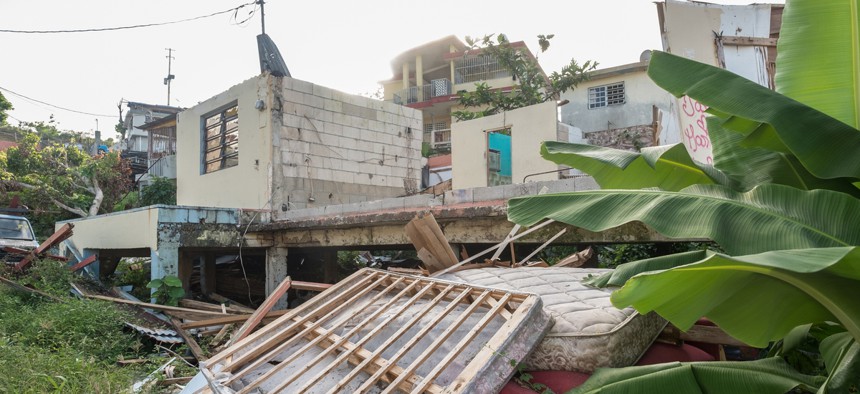Researchers Are Still Counting the Dead From Hurricane Maria

A photo of a house destroyed by Hurricane Maria in Puerto Rico taken in December 2017. Shutterstock
The newest estimate based on administrative data suggests over 1,100 people were killed by the 2017 storm and its fallout.
The one-year anniversary of Hurricane Maria is next month. The island is still rebuilding, still preparing for a new hurricane season, still putting its power grid back together, and still dealing with the massive demographic, environmental, and political changes that have taken place as a result of last year’s disaster. And it’s still trying to figure out just who was lost in the catastrophe—the official death toll still sits at 64, a number we know to be at least an order of magnitude lower than the real count.
A new analysis published Wednesday in the Journal of the American Medical Association helps shed some light on the true toll. That analysis, from the researchers Alexis Raúl Santos-Lozada at Pennsylvania State University and Jeffrey T. Howard at the University of Texas at San Antonio, finds that there were 1,139 excess deaths from September to December 2017 after Maria made landfall. This is a lower number than the 4,600 estimate reported from a survey in The New England Journal of Medicine in May, but is still another piece of data in a growing consensus that Maria was one of the great human catastrophes in American history.
The death toll—and the fact that it’s taking so long for the island to put out reasonable estimates—is a source of tension between the Puerto Rican government, the Puerto Rican people, and the diaspora on the mainland. The idea that the island territory can’t even complete what should be the first recovery step in counting the losses and helping bereaved families is often seen as an indication of the ineptitude, unpreparedness, and bureaucratic malaise that has affected many of the island’s post-Maria decisions.
But what the ongoing effort has illustrated is that coming up with an official death toll is a logistical nightmare in the aftermath of a disaster that sparked a long-term mortality event and a major emigration, and threw Puerto Rico’s finances and governance into further disarray. Death certificates filed on the island could possibly underestimate the number of people who died from disaster-related effects like the loss of power across the island after the storm, while instruments like surveys of survivors could overestimate those deaths. Some people just disappeared, and others were probably quietly buried in a less-than-official capacity.
In June, Governor Ricardo Rosselló faced a significant controversy when his government tried to withhold some administrative data on death counts and then belatedly released the data after a court ordered it to do so. The data was critical to Santos’s and Howard’s research. They compiled official death counts in the seven years before the storm and averaged them month by month to create a baseline death rate. Then they measured the deaths in the months after Hurricane Maria. The differences between those death counts and the baseline are known as “excess deaths,” and they represent people likely killed from the storm and its aftereffects.
The researchers found that Puerto Rico suffered 459 excess deaths in September of 2017, 564 in October, and 116 in November. Since the storm hit the island on September 20, the excess deaths in October point especially to the depths of the misery that the storm created, and to the costs of the collapse of infrastructure and a tepid initial disaster response. “When the area is flooded and without power, that’s not a safe environment for a grandmother on dialysis,” Santos said in a press release. “Essentially, that’s what we’re trying to address. Not just the people who drowned or died in landslides, but also the people who died because they didn’t have access to their basic needs.”
Still, this estimate is only one of several on the death toll of Hurricane Maria. Several journalists and independent researchers had earlier reached similar numbers of about 1,000 deaths. The previous major study in the NEJM from Harvard researchers, which found more than 4,000 deaths, relied on a methodology that was different from any of these efforts. Santos and Howard criticize that methodology in their paper. “It was based on a survey that underestimated prehurricane mortality, overestimated posthurricane mortality, and had a large [confidence interval], indicating a high level of uncertainty,” they write.
There’s plenty of ground still left to cover. Researchers at George Washington University’s Milken Institute School of Public Health have embarked on what many believe will be the authoritative say in the matter, a comprehensive analysis of data provided by Puerto Rico’s government, which is expected out before the end of the summer. Yet it seems reasonable to think now that the baseline of somewhere north of 1,000 people lost from the disaster is a good estimate. The bad news is that estimate still makes Hurricane Maria the second-worst natural disaster on American soil in a century, behind Hurricane Katrina.
Vann R. Newkirk II is a staff writer at The Atlantic, where this article was originally published.
NEXT STORY: After Parkland, States Pass 50 New Gun-Control Laws





